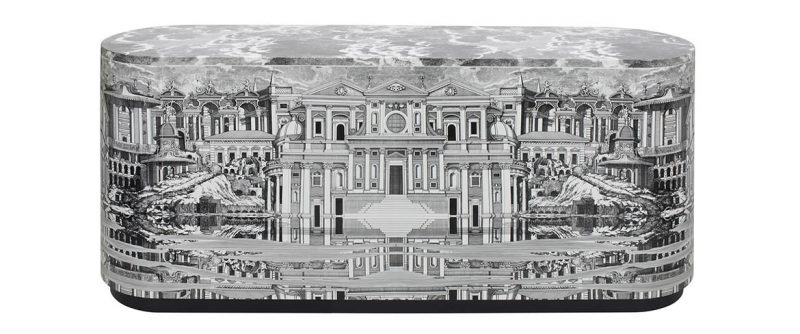Director Bo Nilsson on the artistry of Piero Fornasetti

The FORNASETTI Inside Out Outside In exhibition runs between June 14th, 2019 and January 26th, 2020.
Drawings. Paintings. Furniture. Graphic design. Piero Fornasetti did everything…and then some. In the first Swedish museum exhibition to include Fornasetti’s entire production, Artipelag trains the spotlight on one of the 20th century’s most versatile artists and cultural figures.
Sometimes the best way to open your mind is to immerse yourself in what you’ve previously been avoiding. Artipelag’s director Bo Nilsson had been looking at, experiencing and studying Piero Fornasetti for over 30 years, but had never fully grasped the multi-talented Italian. A new generation of artists paying homage to Fornasetti was the catalyst for finding the right access points. In recent years, his ideas about using the classical in the modern, allowing the traditional to permeate the new, have inspired upcoming talents such as the UK’s Anj Smith. In light of this, the decision to dedicate an exhibition to Fornasetti was easy to make. The time was ripe.
– The popularity of an artist always fluctuates. Fornasetti was yesterday’s news in the 1970s, but grew popular again in the 1980s. Then he fell out of favour again. And now it’s gone full circle and he’s back on top, says Bo Nilsson.
To once and for all get a handle on the prolific artist – who’s believed to have created around 13,000 works in the course of his career – Bo Nilsson decided to put together the most comprehensive exhibition possible. At Artipelag, Fornasetti’s early material, heavily inspired by the Novecento movement, will hang side-by-side with the world-famous design objects featuring 19th century opera singer Lina Cavalieri. Fornasetti’s product and interior design will be mixed with the slightly surreal and very rarely exhibited self-portraits from his years in exile in Switzerland during World War 2. Everything to showcase a versatile total artist who wanted to do, and virtually did, most things during his career.
– We’ve called the exhibition ‘Inside Out Outside In’, which sounds like a paradox, but basically means that we’ll be looking at Fornasetti from the two different perspectives. Our aim is to put together an exhibition that spans his entire production – and interpret it. It starts in our time and works its way back through history. The special layout of this art gallery takes you back the same way you’ve come, meaning you can read the exhibition from two different directions.
Complexity is the very essence of Piero Fornasetti’s artistry. He grew up as part child prodigy, part young rebel. In 1930, at the age of 17, Piero was enrolled at the famous Brera Academy of Fine Arts in Milan, but he was expelled two years later for insubordination. He was destined to spend the rest of the 1930s trying to make a living as an artist and designer in various ways.
It was not until he was discovered by architect and designer Giò Ponti that his career got back on track. Fornasetti’s blend of old and new, of neoclassical references to Italian art history mixed with a more contemporary mindset, appealed to modernist Ponti, who took the talented artist under his wing. In the years that followed, the duo developed a close working relationship, with the 20-year-older Ponti creating furniture and Fornasetti decorating. Together they designed interiors and furnishing concepts for everything from private homes to transatlantic liners, as well as public decorations such as the San Remo casino.
– Ponti tended to favour classic furniture, such as glass cabinets from the Renaissance, but crafted them in simple materials such as Masonite. Meanwhile, Fornasetti’s decorations were inspired by Italian art and architectural history, which made the items of furniture less simple. He often used palace facades to print on screens. He was extremely eclectic and open-minded, unpredictable, and highly skilled at both neoclassical and contemporary design.
Bo Nilsson gladly returns to the idea of Fornasetti as a total artist. The Italian started as a painter, but gradually became involved in a variety of aesthetic disciplines, working as a sculptor, interior designer and product designer. Perhaps this was particularly evident once his partnership with Ponti came to an end. If he and Ponti had worked a lot with the interior design of larger rooms and installations, in the 1960s Fornasetti became more and more focused on the small scale. Back in 1956, Fornasetti opened a shop in his home city of Milan where he started to sell, for want of a better word, merchandise.
– A new middle class searching for its cultural values emerged in the 1960s and Fornasetti was a good fit for this. He made everything from umbrella stands and plates to ashtrays and trays. Everything. We try to understand his motivation in this exhibition, reports Bo Nilsson.
It seems only to be expected that an artist who once said, “A beautiful thing never loses its value, even if it’s mass-produced” would move in this direction.
– Fornasetti had democratic principles – the objects that he created should not only to be accessible to some kind of upper class. He wanted everyone to be able to buy his items. The downside of this is that production gets very fragmented, you no longer have as clear an understanding of the relationship between the different objects. If you give it a certain structure, as we’ve attempted to do in the exhibition, you see that there are patterns in a tradition stretching back to the Renaissance. There are natural motifs, such as fish, flowers and fruit, but there are also artefacts, such as musical instruments, armour and often cultural objects. Nature and culture are contrasted as opposites – Fornasetti in a nutshell.
This is an article from the Artipelag yearly magazine produced in 2019 by Make Your Mark. Text: Mattias Dahlström.